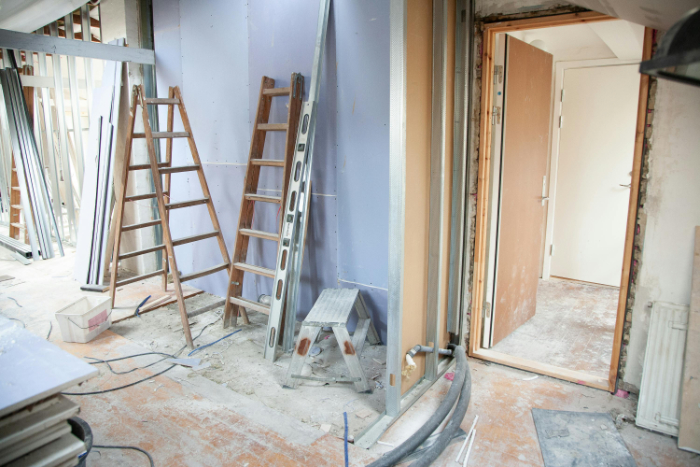Remodeling your entire home? That’s exciting! But also daunting. Transforming all of your living spaces into your dream home is a big deal. We’ve put together this detailed guide to help you prep for a whole house remodel. Let’s jump right in!

How to Prep for a Whole House Remodel
Everything needs careful planning, whether it’s updating outdated rooms, changing room layouts, or opening more space for the family. Having a solid plan can make your home remodel project seamless and hassle-free.
Before you can begin the home renovation work, you need to prepare your home and yourself to reduce stress on your end. Here’s how you can do it for the whole house remodeling project:
1. Make a Detailed Plan with Your General Contractor
The first step when you prep for a whole house remodel is to talk with a renovation expert like Elite Contractors Services. It’s critical to set the scope of the project. Finalize every detail before starting the project, including:
- Timeline: This will show how long each phase of the whole home remodel will take and when major disruptions will happen.
- Areas Affected: Determine which rooms in your home will be under construction. You also need to consult an electrician to change the electrical wiring and an interior designer for your home’s looks. This will help you decide where to transfer and keep your belongings in the meantime.
- Noise and Dust Control: Ask your contractor how they plan to manage dust, noise, and debris to reduce the impact and hassle of cleaning your home extensively.
2. Declutter and Organize
Remodeling your home means you need to move some of your things to another room for a while. Take this time to declutter and organize your things. Label three big boxes with the words “keep,” “donate,” and “discard” to sort your items.
Go to each room and bring the boxes with you to start sorting. Think about which item to keep because you can still use it. Sell or donate unwanted items as long as they’re in good condition to help others while freeing your home from clutter.
3. Arrange Temporary Living Spaces
One aspect of remodeling projects is the need to create temporary living spaces. You may lose access to kitchens, bathrooms, and bedrooms, depending on how extensive the project is.
Prepare for this adjustment by:
- Setting Up a Temporary Kitchen: When remodeling your kitchen, assign an area where you can temporarily prepare your meals. Prepare portable appliances such as microwaves, toaster ovens, and electric kettles. Include a small dining area, too.
- Planning for Bathroom Access: If multiple bathrooms are under construction, assign at least one main bathroom that remains functional during the project. A bathroom renovation may take weeks to complete, so having a working one as the project progresses is a must.
- Creating a Living Space: If the bedroom and living room are remodeled, set up a makeshift sleeping area in an undisturbed area of your home. When needed, you can sleep in the guest room or basement. Make sure you and your kids have enough space to move around while construction is ongoing.
Home renovations and remodeling can stress everyone out, but it’s essential to help them understand the situation and put up with the hassle for just a little while.
4. Protect Your Belongings
Dust, debris, and potential damage are part of a home renovation project. You need to protect your belongings from getting ruined by the construction mess, even if your contractor can help with this issue.
First, cover all your furniture with drop cloths or plastic covers to protect it from dust. Then, tell your contractor to set up tarps to cover limits and sections in work areas for extra protection. It’s important to remember that pests love newly renovated homes so you’ll want to prepare for that as well.
Move your valuable items, such as antiques, artwork, and electronics, from the house and store them in temporary storage units or a nearby relative’s home. Lastly, secure your jewelry, important documents, and other personal items away from the construction zone. Store them in your guest room or an unnoticeable part of your bedroom.
5. Prepare for Setbacks and Delays
Challenges and unexpected issues can still arise even with careful planning of your home project. Most of the time, these things are out of your control. Material shipments can be delayed, or some structural issues might push the project back by weeks.
To avoid feeling frustrated, set realistic expectations for the project. The contractor can estimate the timeline, but you should still plan for buffer times for unforeseen delays. Communicate with your contractor to get updates on the project’s progress in real-time.
Save up to 10-20% on top of your actual budget as a contingency fund to spend on unexpected repairs or design changes. That way, you won’t have to worry about getting short of money when it comes to sudden expenses.
Despite the delays, visit the construction zones in your home regularly to monitor the progress. You should also be flexible with your design choices, especially if your material is too expensive or unavailable.
Final Thoughts
Maybe your goal was to make your home feel more luxurious. Perhaps was to expand the living spaces. Either way, when you prep for a whole house remodel you’ll want to ensure that all your items are protected well. Whether you’re opening your floor plan to accommodate more people or updating your house’s look, decluttering and protecting valuables can reduce stress and lead to a successful remodel. Proper planning will help you navigate every part of the house remodel without any worries.



